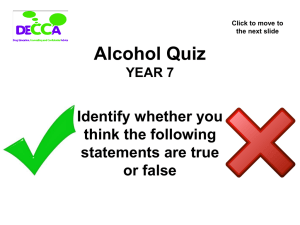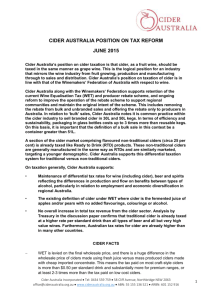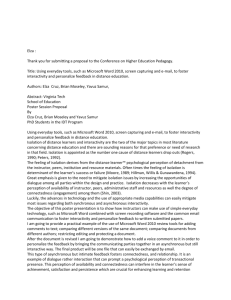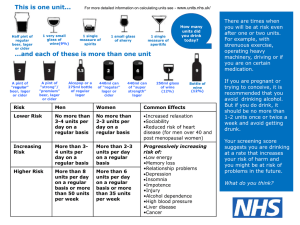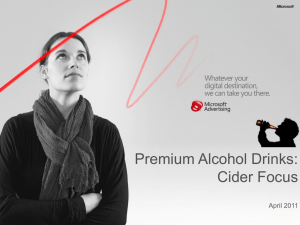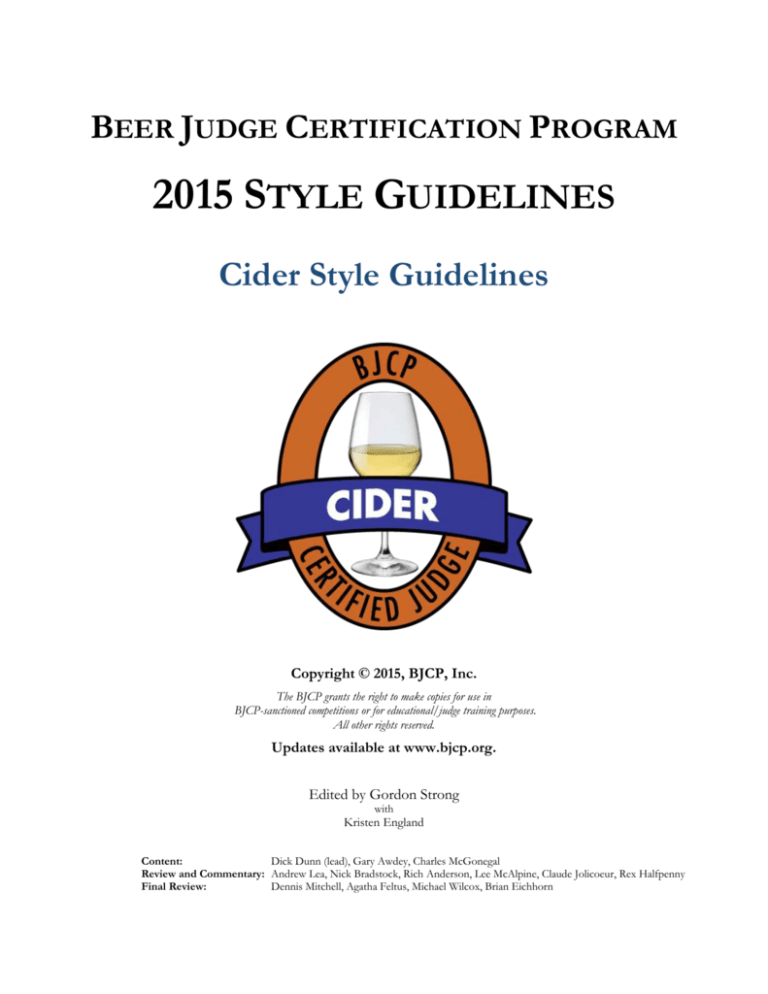
BEER JUDGE CERTIFICATION PROGRAM
2015 STYLE GUIDELINES
Cider Style Guidelines
Copyright © 2015, BJCP, Inc.
The BJCP grants the right to make copies for use in
BJCP-sanctioned competitions or for educational/judge training purposes.
All other rights reserved.
Updates available at www.bjcp.org.
Edited by Gordon Strong
with
Kristen England
Content:
Dick Dunn (lead), Gary Awdey, Charles McGonegal
Review and Commentary: Andrew Lea, Nick Bradstock, Rich Anderson, Lee McAlpine, Claude Jolicoeur, Rex Halfpenny
Final Review:
Dennis Mitchell, Agatha Feltus, Michael Wilcox, Brian Eichhorn
Contents
INTRODUCTION TO CIDER GUIDELINES (CATEGORIES C1-C2) ................................................................................ 1
Aroma and Flavor .......................................................................................................................................... 1
Appearance .................................................................................................................................................... 1
Mouthfeel ....................................................................................................................................................... 2
Ingredients ..................................................................................................................................................... 2
C1. STANDARD CIDER AND PERRY .......................................................................................................................... 3
C1A. New World Cider ................................................................................................................................... 3
C1B. English Cider ......................................................................................................................................... 3
C1C. French Cider .......................................................................................................................................... 3
C1D. New World Perry .................................................................................................................................. 4
C1E. Traditional Perry ................................................................................................................................... 4
C2. SPECIALTY CIDER AND PERRY .......................................................................................................................... 5
C2A. New England Cider ............................................................................................................................... 5
C2B. Cider with Other Fruit .......................................................................................................................... 5
C2C. Applewine.............................................................................................................................................. 5
C2D. Ice Cider ................................................................................................................................................ 5
C2E. Cider with Herbs/Spices ...................................................................................................................... 6
C2F. Specialty Cider/Perry ........................................................................................................................... 6
BJCP Cider Style Guidelines – 2015 Edition
i
INTRODUCTION TO CIDER GUIDELINES (CATEGORIES C1-C2)
The following discussion applies to all the cider styles, except where explicitly superseded in the sub-category guidelines. This
introduction identifies common characteristics and descriptions for all types of cider, and should be used as a reference whenever
entering or judging cider.
Cider is fermented apple juice. Perry is fermented pear juice. There are two categories for cider and perry: Standard Cider and
Perry (Category C1) and Specialty Cider and Perry (Category C2). The Standard category covers ciders and perries made primarily or
entirely from the juice of apples or pears (but not both at once). The only adjunct permitted in the Standard category, and only in
some sub-categories, is a limited addition of sugar to achieve a suitable starting gravity or to raise sweetness post-fermentation. Note
that honey is not a “sugar” for this purpose; a cider made with added honey must be entered either as a Specialty cider or as a Cyser
under the appropriate mead sub-category. Other sugar sources that also add significant flavors (brown sugar, molasses) would also
create a Specialty cider (such as New England style).
Aroma and Flavor
Ciders and perries do not necessarily present overtly
fruity aromas or flavors — in the same sense that a wine
does not taste overtly of grapes. Drier styles of cider in
particular develop more complex but less fruity
characters. A simple apple soda or wine cooler
character is not desirable in a cider or perry.
Some styles of cider exhibit distinctly non-fruity tastes
or aromas, such as the smoky ham undertones of a dry
English cider.
The sweetness (residual sugar, or RS) of a cider or
perry may vary from absolutely dry (no RS) to as much
as a sweet dessert wine (10% or more RS). In sweeter
ciders, other components of taste — particularly acidity
— must balance the sweetness. The level of sweetness
must be specified so organizers and judges can arrange
flights of tastings and entries within flights. Tasting
should always proceed from drier to sweeter. There are
five categories of sweetness, expanded from three in
earlier guidelines. Note that the numbers for these
levels are not rigid or restrictive. They are intended to
guide the cidermaker on how to enter, not to be used as
judging criteria unless a cider is declared at a sweetness
level far from its actual sweetness. Judges must realize
that sweetness can mask faults. Be more attentive to
this in a sweeter cider. Likewise, do not penalize dry
ciders excessively for minor faults which may be more
evident only because of lack of sweetness. The
categories and approximate sugar levels are as follows.
Final gravities are particularly rough numbers since
they cannot take account of what the SG would be if the
cider fermented out completely.
o Dry: below 0.4% residual sugar. This
corresponds to a final specific gravity less than
1.002. There is no perception of sweetness.
o Medium-dry: 0.4-0.9% residual sugar. This
corresponds to a final specific gravity of 1.0021.004. There is a hint of sweetness but the
cider is still perceived primarily as dry. Also
known as semi-dry.
o Medium: in the range between dry and sweet,
0.9-2.0% residual sugar, final gravity 1.0041.009. Sweetness is now a notable component
of the overall character.
o Medium-sweet: 2.0-4.0% residual sugar,
final gravity 1.009-1.019. The cider is sweet but
still refreshing. Also known as semi-sweet.
o Sweet: above 4.0% residual sugar, roughly
equivalent to a final gravity of over 1.019. The
cider has the character of a dessert wine. It
must not be cloying; see notes on balance.
If a cider is close to one of these boundaries, it should
be identified by the sweetness category which best
describes the overall impression it gives. The five
categories above were expanded from the earlier three
dry-medium-sweet by splitting the dry and medium
categories.
Acidity is an essential element of cider and perry: it
must be sufficient to give a clean, refreshing impression
without being puckering. Acidity (from malic and in
some cases lactic acids) must not be confused with
acetification (from ethyl acetate or acetic acid—
vinegar). The acrid aroma and tingling taste of
acetification is a fault.
Ciders and perries vary considerably in tannin. This
affects both bitterness and astringency (see Mouthfeel
below). If made from culinary or table fruit, tannins are
typically low; nevertheless some tannin is desirable to
balance the character. The character contributed by
tannin should be mainly astringency rather than
bitterness. An overt or forward bitterness is a fault, and
is often due to processing techniques rather than fruit
character.
Cider may go through a malo-lactic fermentation
(MLF) which converts some or all of the sharp malic
acid to softer, less-acidic lactic acid. (Perries should not
go through MLF because it will cause undesirable
acetification.) In ciders made with tannic apples, the
MLF commonly produces ethylphenols which are
evident as other flavors: spicy/smoky including smoked
meat, phenolic, and farmyard/old-horse. These flavors
are desirable although not mandatory in English and
French styles, but must not be over the top. The spicysmoky character is the most desirable of the three. Note
that a dominating farmyard character may be the result
of a Brettanomyces contamination rather than MLF;
this is a serious fault. Also, because MLF reduces the
acidity of a cider, the result should not be flabby or too
soft; the cider must remain refreshing. Finally, judges
should be attentive to the possibility of faults such as
mousiness which are more likely in a higher pH cider
that has gone through MLF. (Some judges may be
unable to detect mouse; an alkaline oral rinse may be
needed to confirm and reach agreement among judges.)
Appearance
Clarity may vary from good to brilliant. The lack of
sparkling clarity is not a fault, but visible particles are
undesirable. In some styles a “rustic” lack of brilliance is
BJCP Cider Style Guidelines – 2015 Edition
1
common. Perries are notoriously difficult to clear; as a
result a slight haze is not a fault. However, a “sheen” in
either cider or perry generally indicates the early stage
of lactic contamination and is a distinct fault.
Carbonation may vary from entirely still to a
champagne level. No or little carbonation is termed
still. A still cider may give a slight tickle on the tongue.
A moderate carbonation level is termed petillant.
Highly carbonated is termed sparkling. At the higher
levels of carbonation, the mousse (head) may be
retained for a short time. However, gushing, foaming,
and difficult-to-manage heads are faults.
Mouthfeel
In general, cider and perry have a body and fullness
akin to a light wine. The body is much less than that of
beer. Mouthfeel depends on tannin level. Tannic styles
(English and French) will have astringent mouthfeel
resembling a red wine. Full-sparkling ciders will be
champagne-like.
Ingredients
2
The apple and pear varieties are intended to illustrate
commonly used examples, not dictate requirements
when making the style. In general, adjuncts and
additives are prohibited except where specifically
allowed in particular styles, and then the entrant must
state them. Common processing aids, and enzymes, are
generally allowed as long as they are not detectable in
the finished cider. Yeast used for cider/perry may be
either natural (the yeast which occurs on the fruit itself
and/or is retained in the milling and pressing
equipment) or cultured yeast. Malo-lactic fermentation
is allowed, either naturally occurring or with an added
ML culture. Enzymes may be used for clarification of
the juice prior to fermentation. Malic acid may be added
to a low-acid juice to bring acidity up to a level
considered safe for avoiding bacterial contamination
and off-flavors (typically pH 3.8 or below). Sulfites may
be added as needed for microbiological control. If used,
the maximum accepted safe level for sulfites (200 mg/l)
must be strictly observed; moreover, any excess sulfite
that is detectable in the finished cider (a “burning
match” character) is a serious fault.
If a cider is to have sweetness (residual sugar), this may
be obtained by arresting fermentation or backsweetening with sugar or fresh juice. In this case,
entrant must ensure that the cider is stable. Turbidity,
gushing, or foaming resulting from restarted
fermentation in-bottle are considered serious faults.
If the cider is fermented and/or aged with wood (barrel,
chips, staves/strips), the type of wood and process must
be declared. Except for category C2F (Specialty
Cider/Perry), the wood character must be no more than
barely recognizable. A cider with substantial
wood/barrel character entered in any category other
than C2F will be regarded as not in the style.
Sorbate may be added at bottling to stabilize the cider.
However, any residual aroma/flavor from excessive use
or misuse of sorbate (e.g., a geranium note) is a distinct
fault.
Carbonation may be either natural (by maintaining CO2
pressure through processing or by bottle-conditioning)
or added (by CO2 injection). In most categories, a still
(completely uncarbonated) cider is appropriate. Judges
must realize that carbonation can improve a naive
impression of a cider and must not penalize still ciders
(when declared properly) for lack of carbonation.
BJCP Cider Style Guidelines – 2015 Edition
C1. STANDARD CIDER AND PERRY
The styles represented in this category are the principal established styles. “New World” is simply a name change from the “Common”
of earlier versions.
There are known styles not represented here. In particular, Spanish (Asturian and Basque) does not yet have a style definition
because there is presently insufficient appreciation and understanding, as well as a lack of commercial examples of known quality for
reference.
In the case of a cider made to a style not explicitly represented here, it should be entered in the closest applicable category. The first
decision is whether the cider was made with apples with significant tannin content that gives the cider noticeable astringency or
bitterness. If not, it should be entered as a New World Cider. If so, the choice is between the English and French sub-categories; this
decision should be based on whether the cider tends more toward sweet, rich, somewhat fruity (French) or drier and more austere
(English). For perry of a non-represented style, the decision is, as above, based on tannin content. If in doubt, enter as New World
Perry.
C1A. New World Cider
A New World Cider is made from culinary/table apples, with
wild or crab apples often used for acidity/tannin balance.
Compared to other styles in this category, these ciders are
generally relatively lower in tannin and higher in acidity. “New
World” references the style, not a location, as ciders in this style
are also made in eastern England, Australia, Germany, etc.
Overall Impression: A refreshing drink of some substance –
not bland or watery. Sweet ciders must not be cloying. Dry ciders
must not be too austere.
Aroma/Flavor: Sweet or low-alcohol ciders may have apple
aroma and flavor. Dry ciders will be more wine-like with some
esters. Sugar and acidity should combine to give a refreshing
character. Acidity is medium to high, refreshing, but must not be
harsh or biting.
Appearance: Clear to brilliant, pale to medium gold in color.
Mouthfeel: Medium body. Some tannin should be present for
slight to moderate astringency, but little bitterness.
Comments: An ideal cider serves well as a “session” drink, and
suitably accompanies a wide variety of food.
Entry Instructions: Entrants MUST specify carbonation level
(3 levels). Entrants MUST specify sweetness (5 categories). If
OG is substantially above typical range, entrant should explain,
e.g., particular variety of apple giving high-gravity juice.
Varieties: Common (Winesap, Macintosh, Golden Delicious,
Braeburn, Jonathan), multi-use (Northern Spy, Russets,
Baldwin), crabapples, any suitable wildings.
Vital Statistics: OG:
1.045 – 1.065
FG:
0.995 – 1.020
ABV:
5 – 8%
Commercial Examples: [US] Uncle John’s Fruit House
Winery Apple Hard Cider, Tandem Ciders Pretty Penny (MI),
Bellwether Spyglass (NY), West County Pippin (MA), White
Winter Hard Apple Cider (WI), Wandering Aengus Ciderworks
Bloom (OR), Æppeltreow Appely Brut and Doux (WI).
C1B. English Cider
English Cider includes the English “West Country” plus ciders
inspired by that style. These ciders are made with bittersweet
and bitter-sharp apple varieties cultivated specifically for cider
making. English ciders are traditionally fermented and aged in
wood barrels, which adds some character; however, the barrels
used are rarely new, so there is no overt wood character.
Overall Impression: Generally dry, full-bodied, austere.
Complex flavor profile, long finish.
Aroma/Flavor: No overt apple character, but various flavors
and esters that suggest apples, particularly tannic varieties.
English-style ciders commonly go through MLF (see
Introduction/Aroma-and-Flavor) which produces desirable
spicy/smoky, phenolic, and farmyard/old-horse characters.
These flavor notes are positive but not required. If present, they
must not dominate; in particular, the phenolic and farmyard
notes should not be heavy. A strong farmyard character without
spicy/smoky or phenolic suggests a Brettanomyces
contamination, which is a fault. Mousiness is a serious fault.
Appearance: Barely cloudy to brilliant. Medium yellow to
amber color.
Mouthfeel: Full. Moderate to high tannin, perceived as
astringency and some bitterness. Carbonation still to moderate.
Bottle-fermented or -conditioned ciders may have high
carbonation, up to champagne levels, but not gushing or
foaming.
Comments: Sweet examples exist, but dry is most traditional,
particularly when considering the drying contributions of tannin.
Entry Instructions: Entrants MUST specify carbonation level
(3 levels). Entrants MUST specify sweetness (dry through
medium-sweet, 4 levels). Entrants MAY specify variety of apple
for a single varietal cider; if specified, varietal character will be
expected.
Varieties: Kingston Black, Stoke Red, Dabinett, Porter’s
Perfection, Nehou, Yarlington Mill, Major, various Jerseys, etc.
Vital Statistics: OG:
1.050 – 1.075
FG:
0.995 – 1.015
ABV:
6 – 9%
Commercial Examples: [US] Westcott Bay Traditional Very
Dry, Dry and Medium Sweet (WA), Farnum Hill Extra-Dry, Dry,
and Farmhouse (NH), Wandering Aengus Oaked Dry (OR),
Montana CiderWorks North Fork (MT), Bellwether Heritage
(NY).
[UK] Oliver’s Traditional Dry, Hogan’s Dry and Medium Dry,
Henney’s Dry and Vintage Still, Burrow Hill Medium, Aspall
English Imperial.
C1C. French Cider
French Cider includes Normandy styles plus ciders inspired
by those styles, including ciders made by various techniques to
achieve the French flavor profile. These ciders are made with
bittersweet and bitter-sharp apple varieties cultivated
specifically for cider making.
Traditional French procedures use small amounts of salt and
calcium compounds (calcium chloride, calcium carbonate) to
aid the process of pectin coagulation. These compounds may be
used, pre-fermentation, but in limited quantity. It is a fault if
judges can detect a salty or chalky taste. The enzyme PME
(pectin methyl esterase) may also be used pre-fermentation for
pectin coagulation.
BJCP Cider Style Guidelines – 2015 Edition
3
Note that the sweetness/gravity levels indicate an overall
tendency, not a sharp delineation between English and French
ciders.
Overall Impression: Medium to sweet, full-bodied, rich.
Aroma/Flavor: Fruity character/aroma. This may come from
slow or arrested fermentation (in the French technique of
défécation) or approximated by back-sweetening with juice.
Tends to a rich fullness. MLF notes of spicy-smoky, phenolic,
and farmyard are common but not required (just as with English
style), and must not be pronounced. The French expect more
subtle MLF character than do the English.
Appearance: Clear to brilliant, medium yellow to amber color.
Mouthfeel: Medium to full, mouth-filling. Moderate tannin,
perceived mainly as astringency. Carbonation moderate to
champagne-like, but at higher levels it must not gush or foam.
Comments: Typically made sweet to balance the tannin levels
from the traditional apple varieties.
Entry Instructions: Entrants MUST specify carbonation level
(3 levels). Entrants MUST specify sweetness (medium to sweet
only, 3 levels). Entrants MAY specify variety of apple for a single
varietal cider; if specified, varietal character will be expected.
Varieties: Nehou, Muscadet de Dieppe, Reine des Pommes,
Michelin, etc.
Vital Statistics: OG:
1.050 – 1.065
FG:
1.010 – 1.020
ABV:
3 – 6%
Commercial Examples: [US] West County Reine de Pomme
(MA), [France] Eric Bordelet (various), Etienne Dupont, Etienne
Dupont Organic, Bellot
C1D. New World Perry
New World Perry is made from culinary/table pears.
Overall Impression: Mild. Medium to medium-sweet. Still to
lightly sparkling. Only very slight acetification is acceptable.
Mousiness, ropy/oily characters are serious faults.
Aroma/Flavor: There is a pear character, but not obviously
fruity. It tends toward that of a young white wine. No bitterness.
Appearance: Slightly cloudy to clear. Generally quite pale.
Mouthfeel: Relatively full, low to moderate tannin apparent as
astringency.
Comments: Some table pears may contain significant amounts
of sorbitol, in which case a dry perry may give an impression of
sweetness due to sorbitol in the pears. Perception of sorbitol as
sweet is highly variable from one person to the next. Hence,
entrants should specify sweetness according to actual residual
4
sugar amount, and judges must be aware that they might
perceive more sweetness than how the perry was entered.
Entry Instructions: Entrants MUST specify carbonation level
(3 levels). Entrants MUST specify sweetness (5 categories).
Varieties: Bartlett, Kiefer, Comice, Conference, etc.
Vital Statistics: OG:
1.050 – 1.060
FG:
1.000 – 1.020
ABV:
5 – 7%
Commercial Examples: [US] White Winter Paarynat (WI),
Uncle John’s Fruit House Winery Perry (MI)
C1E. Traditional Perry
Traditional perry is made from pears grown specifically for
that purpose rather than for eating or cooking. Many “perry
pears” are nearly inedible due to high tannins; some are also
quite hard. Perry pears may contain substantial amounts of
sorbitol, a non-fermentable sweet-tasting compound. Hence a
perry can be completely dry (no residual sugar) yet taste sweet.
Overall Impression: Tannic. Medium to medium-sweet. Still
to lightly sparkling. Only very slight acetification is acceptable.
Mousiness and ropy/oily characters are serious faults.
Aroma/Flavor: There is a pear character, but not obviously
fruity. It tends toward that of a young white wine. Some slight
bitterness.
Appearance: Slightly cloudy to clear. Generally quite pale.
Mouthfeel: Relatively full, moderate to high tannin apparent as
astringency.
Comments: Note that a dry perry may give an impression of
sweetness due to sorbitol in the pears, and perception of sorbitol
as sweet is highly variable from one person to the next. Hence
entrants should specify sweetness according to actual residual
sugar amount, and judges must be aware that they might
perceive more sweetness than how the perry was entered.
Entry Instructions: Entrants MUST specify carbonation level
(3 levels). Entrants MUST specify sweetness (5 categories).
Entrants MUST state variety of pear(s) used.
Varieties: Butt, Gin, Brandy, Barland, Blakeney Red, Thorn,
Moorcroft, etc.
Vital Statistics: OG:
1.050 – 1.070
FG:
1.000 – 1.020
ABV:
5 – 9%
Commercial Examples: [US] Æppeltreow Orchard Oriole
Perry (WI); [France] Bordelet Poire Authentique and Poire
Granit, Christian Drouin Poire, [UK] Oliver’s Classic, Blakeney
Red, and Herefordshire Dry; Hogan’s Vintage Perry.
BJCP Cider Style Guidelines – 2015 Edition
C2. SPECIALTY CIDER AND PERRY
Specialty cider/perry includes beverages made with added flavorings (spices and/or other fruits), those made with substantial
amounts of sugar-sources to increase starting gravities, and the beverage made from a combination of apple and pear juice
(sometimes called pider).
The same general characteristics and fault descriptions apply to specialty ciders as to standard ciders (preceding category), with the
exception of added ingredients allowed.
C2A. New England Cider
This is a cider made with characteristic New England apples for
relatively high acidity, with additives to raise alcohol levels and
contribute additional flavor notes.
Overall impression: Substantial body and character. Typically
relatively dry, but can be somewhat sweet if in balance and not
containing hot alcohol.
Aroma/Flavor: A flavorful cider with robust apple character,
strong alcohol, and derivative flavors from sugar additives;
traditionally dry.
Appearance: Clear to brilliant, pale to medium yellow.
Mouthfeel: Substantial, alcoholic. Moderate tannin.
Comments: Additives may include white and brown sugars,
molasses, small amounts of honey, and raisins. Additives are
intended to raise OG well above that which would be achieved by
apples alone. This style is sometimes barrel-aged, in which case
there will be oak character as with a barrel-aged wine. If the
barrel was formerly used to age spirits, some flavor notes from
the spirit (e.g., whisky or rum) may also be present, but must be
subtle.
Entry Instructions: Entrants MUST specify if the cider was
barrel-fermented or aged. Entrants MUST specify carbonation
level (3 levels). Entrants MUST specify sweetness (5 levels).
Varieties: Northern Spy, Roxbury Russet, Golden Russet,
Baldwin, etc.; many traditional New England apples.
Vital Statistics: OG:
1.060 – 1.100
FG:
0.995 – 1.020
ABV:
7 – 13%
Commercial Examples: [US] Snowdrift Semi-Dry (WA),
Blackbird Cider Works New England Style (NY).
C2B. Cider with Other Fruit
This is a cider with other fruits or fruit-juices added – for
example, berry. This is the correct style to enter a beverage
fermented from a combination of apple and pear juice.
Overall Impression: Like a white wine with complex flavors.
The apple character must marry with the added fruit so that
neither one dominates the other.
Aroma/Flavor: The cider character must be present and must
fit with the other fruits. It is a fault if the added fruit(s)
completely dominate; a judge might ask, Would this be different
if neutral spirits replaced the cider? A fruit cider should not be
like an alco-pop. Oxidation is a fault.
Appearance: Clear to brilliant. Color appropriate to added
fruit, but should not show oxidation characteristics. (For
example, red berries should give red-to-purple color, not
orange.)
Mouthfeel: Substantial. May be significantly tannic, depending
on fruit added.
Entry Instructions: Entrants MUST specify carbonation level
(3 levels). Entrants MUST specify sweetness (5 categories).
Entrants MUST specify all fruit(s) and/or fruit juice(s) added.
Vital Statistics: OG:
1.045 – 1.070
FG:
0.995 – 1.010
ABV:
5 – 9%
Commercial Examples: [US] West County Blueberry-Apple
Wine (MA), Bellwether Cherry Street (NY), Uncle John’s Fruit
Farm Winery Apple Cherry, Apple Blueberry, and Apricot Apple
Hard Cider (MI)
C2C. Applewine
The term for this category is traditional but possibly
misleading: it is simply a cider with substantial added sugar to
achieve higher alcohol than a standard cider. As such it comes
closer to a white wine than any other style. No fruit other than
apples may be used in this style.
Overall Impression: Typically like a dry white wine, balanced,
and with low astringency and bitterness.
Aroma/Flavor: Comparable to a New World Cider. Cider
character must be distinctive. Very dry to sweet, although often
dry.
Appearance: Clear to brilliant, pale to medium-gold.
Cloudiness or hazes are inappropriate.
Mouthfeel: Lighter than other ciders, because higher alcohol is
derived from addition of sugar rather than juice. Carbonation
may range from still to champagne-like.
Entry Instructions: Entrants MUST specify carbonation level
(3 levels). Entrants MUST specify sweetness (5 levels).
Vital Statistics: OG:
1.070 – 1.100
FG:
0.995 – 1.020
ABV:
9 – 12%
Commercial Examples: [US] Uncle John’s Fruit House
Winery Fruit House Apple (MI), McClure’s Sweet Apple Wine
(IN).
C2D. Ice Cider
This is a cider style in which the juice is concentrated before
fermentation either by freezing fruit before pressing or freezing
juice and removing water. Fermentation stops or is arrested
before reaching dryness. The character differs from Applewine
in that the ice cider process increases not only sugar (hence
alcohol) but acidity and all fruit flavor components
proportionately. No additives are permitted in this style; in
particular, sweeteners may not be used to increase gravity. This
style originated in Quebec in the 1990s.
Aroma/Flavor: Fruity, smooth, sweet-tart. Acidity must be
enough to prevent it being cloying.
Appearance: Brilliant. Color is deeper than a standard cider,
gold to amber.
Mouthfeel: Full body. May be tannic (astringent and/or bitter)
but this should be slight, to moderate at most.
Entry Instructions: Entrants MUST specify starting gravity,
final gravity or residual sugar, and alcohol level. Entrants MUST
specify carbonation level (3 levels).
Varieties: Usually North American classic table fruit such as
McIntosh or Cortland.
BJCP Cider Style Guidelines – 2015 Edition
5
Vital Statistics: OG:
1.130 – 1.180
FG:
1.060 – 1.085
ABV:
7 – 13%
Commercial Examples: [US] various from Eden Ice Cider
Company and Champlain Orchards. [Canada] Domaine Pinnacle,
Les Vergers de la Colline, and Cidrerie St-Nicolas (Quebec).
C2E. Cider with Herbs/Spices
This is a cider with any combination of “botanicals” added.
Hopped ciders are included in this category. Other examples are
ciders with “apple pie” spices (cinnamon, nutmeg, allspice),
ginger, lemon grass, herbal tea blends, etc.
Overall Impression: Like a white wine with complex flavors.
The apple character must marry with the botanicals and give a
balanced result.
Aroma/Flavor: The cider character must be present and must
fit with the botanicals. As with a fruit cider, it is a fault if the
botanicals dominate; a judge might ask, Would this be different
if neutral spirits replaced the cider? Oxidation of either the base
cider or the additions is a fault.
Appearance: Clear to brilliant. Color appropriate to added
botanicals.
Mouthfeel: Average or more. Cider may be tannic from effect of
botanicals but must not be bitter from over-extraction.
Entry Instructions: Entrants MUST specify carbonation level
(3 levels). Entrants MUST specify sweetness (5 categories).
Entrants MUST specify all botanicals added. If hops are used,
entrant must specify variety/varieties used.
Vital Statistics: OG:
1.045 – 1.070
FG:
0.995 – 1.010
ABV:
5 – 9%
Commercial Examples: [US] Colorado Cider Grasshop-ah
(CO), Wandering Aengus Anthem Hops (OR).
6
C2F. Specialty Cider/Perry
This is an open-ended category for cider or perry with other
ingredients such that it does not fit any of the categories above.
This includes the use of other sweeteners. A cider with added
honey may be entered here if the cider character remains
dominant; otherwise it should be entered as mead in the cyser
sub-category. Examples also include wood-fermented or aged
ciders in which the wood/barrel character is a significant part
of the overall flavor profile.
Aroma/Flavor: The cider character must always be present,
and must fit with added ingredients. If a spirit barrel was used,
the character of the spirit (rum, whiskey, etc.) must be no more
than just recognizable; it must not be a substantial element of the
flavor.
Appearance: Clear to brilliant. Color should be that of a
standard cider unless other ingredients are expected to
contribute color.
Mouthfeel: Average body, may show tannic (astringent) or
heavy body as determined by other ingredients.
Entry Instructions: Entrants MUST specify all ingredients.
Entrants MUST specify carbonation level (3 levels). Entrants
MUST specify sweetness (5 categories).
Vital Statistics: OG:
1.045 – 1.100
FG:
0.995 – 1.020
ABV:
5 – 12%
Commercial Examples: [US] Finn River Fire Barrel (WA)
BJCP Cider Style Guidelines – 2015 Edition


